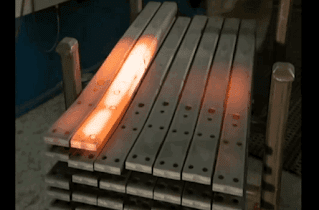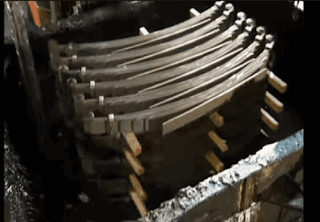Pegas daun ini memiliki kelenturan untuk menyerap turun dan naik kendaraan di jalan.
Namun, juga cukup kuat untuk menopang beban kendaraan. Saat ini pegas suspensi super kuat ini umumnya digunakan untuk truk dan kendaraan berat lainnya lebih dari mobil.
Proses produksi pegas daun dimulai dari pelat baja. itu merupakan paduan yang memiliki elastisitas.
gunting besar memotong baja dengan berbagai ukuran untuk multi-daun pegas.
itu salah satu dari dua jenis pegas daun.
Dengan menggunakan gergaji pita, mereka memotong baja untuk jenis pegas daun lainnya yang dikenal sebagai full taper spring.
itu terbuat dari satu sampai empat lapis plat yang kira-kira memiliki panjang yang sama tetapi dengan ketebalan yang bervariasi.
setelah memotong, mereka dengan cepat memanaskan ujungnya, mesin terkomputerisasi menggulung dan meregangkan potongan ke profil meruncing.
ini mencapai efek lentur yang sama seperti daun yang semakin pendek pada pegas multi-daun.
tetapi produk akhirnya akan lebih ringan dan tidak kaku.
selanjutnya masuk ke proses tekan yang memotong ujung yang diregangkan dan membuat lubang untuk berbagai komponen.
dibutuhkan sekitar satu jam agar baja menjadi dingin untuk proses berikutnya.
sementara itu anggota tim yang lain sedang bekerja keras untuk merakit pegas yang memiliki banyak daun.
Mereka memasukkan ujung pegas daun utama yang dipanaskan ke mesin yang melipatnya bergulung pada landasan die.
ini membuat lubang pengikat untuk memasang pegas ke kendaraan.
mereka juga membuat lubang pengikat di ujung lainnya.
selanjutnya mereka menggulung ujung batang baja yang sedikit lebih panjang menjadi potongan berbentuk c yang longgar, akan berfungsi sebagai lapisan pelindung luar untuk daun utama dan melindungi lubang pengikat.
kembali ke pegas taper sekarang.
mesin hidrolik membengkokkannya ke bentuk z akhir.
sehingga pas di sekitar poros kendaraan.
mereka merendam pegas lancip dan pegas multi daun dalam oli dan kemudian proses temper dalam tungku untuk memperkuat baja.
maka saatnya untuk proses yang dikenal sebagai peening.
mesin menjepit daun baja ke kereta yang membawanya melalui ruang untuk peledakan dengan pelet baja kecil.
peledakan mengubah tegangan permukaan yang selanjutnya memperkuat logam.
seorang pekerja sekarang merakit pegas multi-daun.
ia memasukkan peniti melalui bagian tengah daun utama dan lapisannya untuk menyelaraskannya.
setiap daun berikutnya lebih pendek dari yang sebelumnya.
mereka dikenal sebagai multi ukuran pegas daun.
Ini adalah desain yang akan membuat pegas lebih fleksibel.
Kemudian dia memindahkan tumpukan ke stasiun hidrolik. Dan menyisipkan pin yang berbeda untuk penyelarasan yang lebih presisi.
ia mengaktifkan mekanisme hidrolik dan menekan plat-daun itu bersama-sama.
mekanisme tersebut menahan plat daun di bawah tegangan saat ia melepaskan pin dan sekarang menguncinya dengan baut.
ia memasang klip yang dipasang di lokasi tertentu pada pegas untuk menutupnya di sekitar daun.
klip mengencangkan tumpukan seluruhnya dan akan menghentikan daun agar tidak terpelintir atau berputar.
berikutnya perangkat hidrolik lain menerapkan tekanan.
kali ini untuk mensimulasikan beban yang akan ditanggung pegas.
ini menyetel pegas ke ketinggian tertentu dan memampatkannya untuk memperkuat kinerja keseluruhan.
pekerja mengukur pegas untuk memastikan bahwa pegas memenuhi spesifikasi.
cat melapisi klip daun dan pengencang untuk memberikan pegas suspensi ini hasil akhir yang seragam.
dicat hitam sehingga harus menyatu dengan semua komponen lain di bagian bawah kendaraan.
Sekarang sudah lengkap, pegas daun ini bisa diandalkan untuk menopang saat keadaan menjadi sulit.
In English Script:
a leaf spring is a stack of curved plates or leaves or sometimes even just one.
this spring has the flex to absorb bumps and dips in the road.
but it's strong enough to provide serious support. today these super strong suspension springs are generally used for trucks and other heavy vehicles more than cars.
production starts with spring steel. it's an alloy that has elasticity.
big shears cut the steel to various lengths for a multi-leaf spring.
it's one of two kinds of leaf springs.
using a band saw, they cut steel for the other kind of leaf spring known as a full taper spring.
it's made of one to four leaves that are approximately the same length but various thicknesses.
after cutting, they rapidly heat the ends, computerized machinery rolls and stretches the piece to a tapered profile.
this achieves the same flex effect as the progressively shorter leaves on the multi-leaf spring.
but the end product will be lighter and not as stiff.
next it's into a press that trims the stretched ends and punches holes for various components.
it takes about an hour for the steel to cool down for the next operation.
meanwhile other members of the team are hard at work on the multi-leaf spring.
they feed the heated tip of the main leaf to a machine that wraps it around a die form.
this creates an eye mount for attaching the spring to the vehicle.
they create an eye mount on the other end as well.
next they curl the ends of a slightly longer steel bar into a loose c-shape this piece, will serve as an outer protective wrap for the main leaf and protect the eye mounts.
back to the taper spring now.
hydraulic machinery bends it to the final z shape.
so it will fit around a vehicle axle.
they quench both the taper and multi-leaf springs in oil and then temper them in a furnace to strengthen the steel.
then it's time for a process known as peening.
machinery clamps the steel leaf onto a carriage which takes it through a chamber for blasting with tiny steel pellets.
the blasting changes the surface tension further strengthening the metal.
a worker now assembles the multi-leaf spring.
he inserts a pin through the center of the main leaf and the wrap to align them.
each of the next leaves is shorter than the last.
they're known as graduated leaves.
it's a design that will make the spring more flexible.
he transfers the stack to a hydraulic station.
and inserts a different pin for more precise alignment.
he activates the hydraulic mechanism and it squeezes the leaves together.
the mechanism maintains the leaves under tension as he removes the pin and now bolts them together.
he pounds clips installed at specific locations on the spring to close them around the leaves.
the clips tighten the stack all the way across and will stop the leaves from twisting or turning.
next another hydraulic device applies pressure.
this time to simulate the load the spring will carry.
this sets the spring to a specific height and compresses it to stiffen the overall performance.
the worker measures the spring to confirm that it meets the specifications.
the assembled leaf springs now take a quick dip in a tank of black paint.
the paint coats the leaves clips and fasteners to give these suspension springs a uniform finish.
painted black they should blend in with all the other components on the vehicle undercarriage.
now complete, these leaf springs can be depended on for support when the going gets rough










